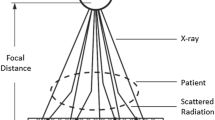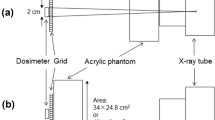Abstract
Full-field digital mammography (FFDM) systems provide the current gold standard in mammographic examinations. Although FFDM provides the lowest mammographic doses, the radiation dose to the breast during mammographic examinations is still a concern. Thus, image quality optimization at the lowest dose is a major goal. In planar X-ray imaging, thin sheets of aluminum (Al) are used as filtration to reduce the number of low-energy X-ray photons reaching the patient. The goal of this work was to evaluate whether Al can be used in FFDM to remove scatter radiation from reaching the image detector, hence improving image quality. Doses were compared with the use of a grid. A Hologic Selenia mammographic unit was used to acquire images of two phantoms, namely, the ACR phantom and a Perspex phantom of 5 cm. Images were acquired using two tube voltages (kVp) and filter combinations under two exposure/dose conditions. Al sheets of various thicknesses were placed between the phantom and the image detector. Contrast-to-noise ratio (CNR) and figure of merit (FOM) values were measured and compared with images acquired using a grid. When a constant dose was delivered to the image detector, the highest CNR was achieved using a grid; however, the highest FOM values were achieved when using 0.05 mm thick Al sheets. This study successfully demonstrates that thin sheets of Al can be used in mammography examinations to reduce scattered radiation and improve image quality, as indicated by the measured CNR values. Given the limitations of this work, further kVp and target/filter combinations and various methods of image quality measurement need to be studied.






Similar content being viewed by others
References
The Swedish Organised Service Screening Evaluation Group. Reduction in breast cancer mortality from organized service screening with mammography with extended data. Cancer Epidemiol Biomark Prev. 2006;15:45–51.
Tabar L, Vitak B, Chen HH, Yen MF, Duffy SW, Smith RA. Beyond randomized controlled trials: organized mammographic screening substantially reduces breast carcinoma mortality. Cancer. 2001;91(9):1724–31.
Tabar L, Yen MF, Vitak B, Chen HH, Smith RA, Duffy SW. Mammography service screening and mortality in breast cancer patients: 20-year follow-up before and after introduction of screening. Lancet (London, England). 2003;361(9367):1405–10.
Chawla AS, Samei E, Saunders R, Abbey C, Delong D. Effect of dose reduction on the detection of mammographic lesions: a mathematical observer model analysis. Med Phys. 2007;34(8):3385–98.
Bushberg J, Seibert J, Leidholdt J, Boone J. The essential physics of medical imaging. 3rd ed. Philadelphia: Lippincott Williams & Wilkins; 2012.
Aminah M, Ng KH, Abdullah BJJ, Jamal N. Optimal beam quality selection based on contrast-to-noise ratio and mean glandular dose in digital mammography. Australas Phys Eng Sci Med. 2010;33(4):329–34.
Kanal KM, Krupinski E, Berns EA, Geiser WR, Karellas A, Mainiero MB, et al. ACR–AAPM–SIIM practice guideline for determinants of image quality in digital mammography. J Digit Imaging. 2013;26(1):10–25.
Yaffe MJ, Bunch PC, Desponds L, Jong RA, Nishikawa RM, Tapiovaara MJ, et al. Technical aspects of image quality in mammography. J Int Comm Radiat Units Meas. 2009;9(2):33–51.
Varjonen M, Strömmer P. Optimizing the anode-filter combination in the sense of image quality and average glandular dose in digital mammography. In: Proc. SPIE 6913, Medical imaging 2008, San Diego, California; 2008.
Williams MB, Raghunathan P, More MJ, Seibert AJ, Kwan A, Lo JY, et al. Optimization of exposure parameters in full field digital mammography. Med Phys. 2008;35(6Part1):2414–23.
The Royal Australian and New Zealand College of Radiologists. Guidelines for quality control testing for digital (CR & DR) mammography. V4.0. 2018. https://www.ranzcr.com.
Xinming L, Chao-Jen L, Whitman GJ, Geiser WR, Youtao S, Ying Y, et al. Effects of exposure equalization on image signal-to-noise ratios in digital mammography: a simulation study with an anthropomorphic breast phantom. Med Phys. 2011;38(12):6489–501.
Borg M, Badr I, Royle G. The use of a figure-of-merit (FOM) for optimisation in digital mammography: a literature review. Radiat Prot Dosim. 2012;151(1):81–8.
Delis H, Spyrou G, Costaridou L, Tzanakos G, Panayiotakis G. Evaluating the Figure of Merit in mammography utilizing Monte Carlo simulation. Nucl Instrum Methods Phys Res Sect A. 2007;580(1):493–6.
Shepard SJ, Wang J, Flynn M, Gingold E, Goldman L, Krugh K, et al. An exposure indicator for digital radiography: AAPM Task Group 116 (Executive Summary). Med Phys. 2009;36(7):2898–914.
Gress DA, Dickinson RL, Erwin WD, Jordan DW, Kobistek RJ, Stevens DM, et al. AAPM medical physics practice guideline 6a: performance characteristics of radiation dose index monitoring systems. J Appl Clin Med Phys. 2017;18(4):12–22.
Koen L, Herbst C, Rae W. Computed radiography exposure indices in mammography. SA J Radiol. 2008;12(2):28–31.
Acknowledgements
The authors would like to thank the staff in the Radiology Department, The Canberra Hospital, Australia, for access to and use of the Hologic Selenia Dimensions digital mammographic unit.
Author information
Authors and Affiliations
Corresponding author
Ethics declarations
Conflict of interest
The authors declare that they have no conflict of interest in undertaking this work or presenting the findings.
Ethical approval
This article does not contain any studies with human participants or animals performed by any of the authors.
Additional information
Publisher's Note
Springer Nature remains neutral with regard to jurisdictional claims in published maps and institutional affiliations.
About this article
Cite this article
Al Khalifah, K., Davidson, R. & Zhou, A. Using aluminum for scatter control in mammography: preliminary work using measurements of CNR and FOM. Radiol Phys Technol 13, 37–44 (2020). https://doi.org/10.1007/s12194-019-00545-3
Received:
Revised:
Accepted:
Published:
Issue Date:
DOI: https://doi.org/10.1007/s12194-019-00545-3




